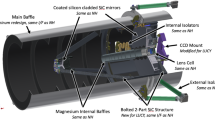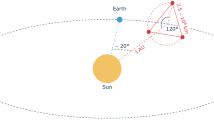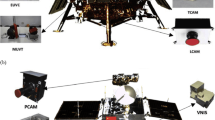Abstract
The Lunar Reconnaissance Orbiter (LRO) was implemented to facilitate scientific and engineering-driven mapping of the lunar surface at new spatial scales and with new remote sensing methods, identify safe landing sites, search for in situ resources, and measure the space radiation environment. After its successful launch on June 18, 2009, the LRO spacecraft and instruments were activated and calibrated in an eccentric polar lunar orbit until September 15, when LRO was moved to a circular polar orbit with a mean altitude of 50 km. LRO will operate for at least one year to support the goals of NASA’s Exploration Systems Mission Directorate (ESMD), and for at least two years of extended operations for additional lunar science measurements supported by NASA’s Science Mission Directorate (SMD). LRO carries six instruments with associated science and exploration investigations, and a telecommunications/radar technology demonstration. The LRO instruments are: Cosmic Ray Telescope for the Effects of Radiation (CRaTER), Diviner Lunar Radiometer Experiment (DLRE), Lyman-Alpha Mapping Project (LAMP), Lunar Exploration Neutron Detector (LEND), Lunar Orbiter Laser Altimeter (LOLA), and Lunar Reconnaissance Orbiter Camera (LROC). The technology demonstration is a compact, dual-frequency, hybrid polarity synthetic aperture radar instrument (Mini-RF). LRO observations also support the Lunar Crater Observation and Sensing Satellite (LCROSS), the lunar impact mission that was co-manifested with LRO on the Atlas V (401) launch vehicle. This paper describes the LRO objectives and measurements that support exploration of the Moon and that address the science objectives outlined by the National Academy of Science’s report on the Scientific Context for Exploration of the Moon (SCEM). We also describe data accessibility by the science and exploration community.
Similar content being viewed by others
References
Chin et al., Lunar reconnaissance orbiter overview: the instrument suite and mission. Space Sci. Rev. 129, 391–419 (2007)
C. Tooley et al., Lunar reconnaissance orbiter mission and spacecraft design. Space Sci. Rev., this issue (2010). doi:10.1007/s11214-009-9624-4
M. Zuber et al., The lunar reconnaissance orbiter laser ranging investigation. Space Sci. Rev., this issue (2010). doi:10.1007/s11214-009-9511-z
Author information
Authors and Affiliations
Corresponding author
Rights and permissions
About this article
Cite this article
Vondrak, R., Keller, J., Chin, G. et al. Lunar Reconnaissance Orbiter (LRO): Observations for Lunar Exploration and Science. Space Sci Rev 150, 7–22 (2010). https://doi.org/10.1007/s11214-010-9631-5
Received:
Accepted:
Published:
Issue Date:
DOI: https://doi.org/10.1007/s11214-010-9631-5




